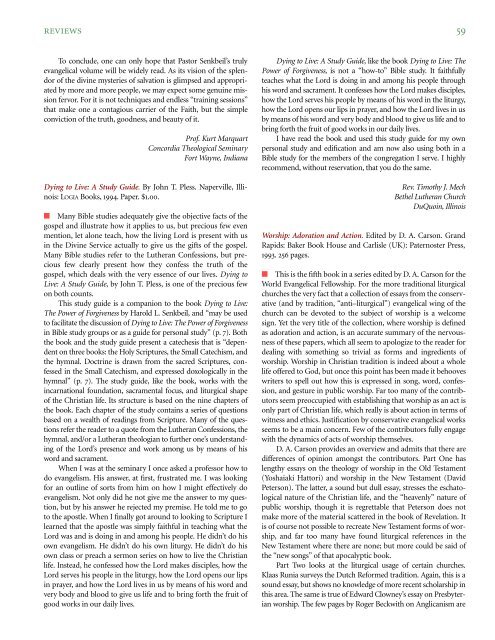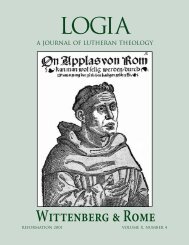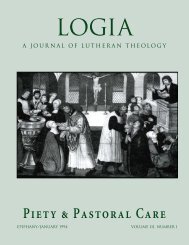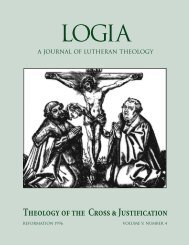58 LOGIAprevalent in Christian bestsellers and so prominent among Christianmedia teachers are at best a dim parody of the Christian lifepresented in the Scriptures.”Clearly, Senkbeil here wishes to lead us to a higher, not alower view of sanctification. The point is not a minor one, sincemodern Lutheran preachers often do not draw the line againstantinomianism as bluntly as did Luther himself. The antinomiansfancy, he said, that one must never speak like this: “Listen! Youwant to be a Christian and at the same time remain an adulterer, awhoremonger, a drunken swine, covetous, a usurer, envious, vindictive,malicious, etc.!” Instead they coo: “Listen! Though you arean adulterer, a whoremonger, a miser, or other kind of sinner, ifyou but believe, you are saved, and you need not fear the law.Christ has fulfilled it all!”No, says Luther, such people “may be fine Easter preachers,but they are very poor Pentecost preachers, for they do not preachabout the sanctification and vivification by the Holy Spirit.” ButChrist won for us not only gratiam, grace, forgiveness, but alsodonum, or the renewing gift of the Spirit. He who “persists in hisevil life, must have a different Christ, that of the Antinomians. ...He must be damned with this, his new Christ” (On the Councilsand the Church, AE 41:113–114).Senkbeil is also a good Pentecost preacher, for he takes therenewing work of the Holy Spirit far more seriously than do thefundamentalist “principles for Christian living.” The truth is, hewrites, that “all of the New Testament imperatives are based onits indicatives. In other words, everything God demands of hischildren he first gives his children” (p. 79). How? “By Holy Baptismthe Triune God crucifies our Old Adam, buries our sin,raises us as a new creation, and clothes us in Jesus Christ—thusgiving us a whole new life to live. This is the authentic formulafor Christian living!”The chapter on Baptism is shaped by the riches of the Exodustheme. Baptism happens only once, at the beginning. The troubleis that the Old Adam, drowned in Baptism, “swims well” (p. 81).Absolution provides for that constant, repeated forgiveness, whichenables us to return to our Baptism daily, ever renewed for thefierce battle unto death between good and evil. “Power of attorney”is one of the many happy phrases Senkbeil coins or applies—in this case to show the divine force of the absolution on the basisof St. John 20:21–23. “Counseling or Consolation?” and “Takingoff our Masks” are other headings that hit upon the essence ofwhat happens in confession and absolution.The Holy Supper likewise receives a rich devotional exposition.“It’s interesting,” remarks Senkbeil, “that the Old Testamentmodels for Baptism and the Lord’s Supper both have a commonorigin in Israel’s deliverance from bondage in Egypt” (p. 100). Asthe Red Sea and the Passover miracles triumphed over the samefoe, Pharaoh, so “the sacraments of Holy Baptism and Communionare signs and seals of Christ’s victory over one ancient foe,the devil.” The subheading “Feast of Life” reflects the special perspectiveof St. John 6, in keeping with the council of Ephesus andFC SD VIII, 59, 76.The interplay of dogma and devotion are vital here. Exceptfor confession and absolution, it is difficult to think of another“chief part” in which the link between Lutheran doctrine andpractice is as weak as in the case of the Lord’s Supper. The doctrineis so “high,” and the practice—since the devastations of pietismand rationalism—so relatively “low.” Given our church’s officialsacramental theology, one would expect the Sacrament of theAltar to be much more prominent and decisive in our church lifethan it actually is. Could this hiatus be the reason why formerlyLutheran churches the world over have drifted almost casuallyinto union with Reformed churches? Instead of warning themagainst such a wholesale surrender of the Sacrament in the senseof the Book of Concord, the “Lutheran” World Federation cannothuff and puff vigorously enough to promote this very betrayal.Bare catechismal formalities, without a corresponding sacramentalpiety, will not preserve the Sacrament for our posterity.Even in “conservative” Lutheran churches, the pressures mountdaily for making the Sacrament play second fiddle to culturalnorms like inclusivism, individualism, consumer-driven “worship,”or “rural values.”In short, one can hardly overestimate the significance ofSenkbeil’s gift for portraying the Holy Sacrament of the Lord’sbody and blood in vivid, primary colors, so that our dearLutheran people may gain a new zeal for these very crown jewelsof their church. Surely this is what Luther meant in the Preface tothe Small Catechism: “We should so preach that, of their ownaccord and without any law, the people will desire the sacramentand, as it were, compel us pastors to administer it to them.”Senkbeil’s text, incidentally, reflects faithfully the two specialoccurrences of the word “true” in the history of Christian confession:The Nicene Creed confessed Jesus as “true God” (“IncarnationalFoundation,” p. 31), and the Lutheran Reformation confessedthe Sacrament as his “true Body and Blood” (“SacramentalFocus,” p. 105).And then there is “The Liturgical Shape,” the final third of thebook. Just as “Incarnational Foundation” entails “SacramentalFocus,” so “Sacramental Focus” entails “Liturgical Shape.” Nonliturgicalworship is for non-sacramental churches. Given thesacramentality of the gospel and sacraments, their concreteembodiment in public worship necessarily means liturgy. Again,Senkbeil captures this dynamic, and makes it meaningful to thereader. He does not overlook the daily prayer aspect of liturgicallife. Already under Baptism much was made of the sign of thecross (pp. 66–68). Later there is more about the part the bodyplays in worship (pp. 154–156). Inhaling and exhaling are usefulanalogies for the sacramental and sacrificial elements of worship(pp. 122 ff.). The Psalms are stressed as the God-given fountainheadof public and private prayer (p. 147).Very important is the final chapter, “Vocation: Liturgical Lifein the World.” What has been called “the liturgy after the liturgy”involves every useful occupation, or as Senkbeil puts it, “Butcher,Baker, Candlestick Maker.” He recaptures the Reformation’s stresson the sanctity of temporal life and work, in the family and insociety at large: “the Christian always lives outside of himself—inChrist by faith and in the neighbor by love” (p. 177). Without thiswe succumb again to a sickly new monasticism for clergy or imitationclergy only.The author of Dying to Live is Pastor of Elm Grove EvangelicalLutheran Church, Elm Grove, Wisconsin. This is his secondbook. He was also vitally involved with the synodical catechismretranslation work a few years ago.
REVIEWS 59To conclude, one can only hope that Pastor Senkbeil’s trulyevangelical volume will be widely read. As its vision of the splendorof the divine mysteries of salvation is glimpsed and appropriatedby more and more people, we may expect some genuine missionfervor. For it is not techniques and endless “training sessions”that make one a contagious carrier of the Faith, but the simpleconviction of the truth, goodness, and beauty of it.Prof. Kurt MarquartConcordia Theological SeminaryFort Wayne, IndianaDying to Live: A Study Guide. By John T. Pless. Naperville, Illinois:LOGIA Books, 1994. Paper. $1.00.■ Many Bible studies adequately give the objective facts of thegospel and illustrate how it applies to us, but precious few evenmention, let alone teach, how the living Lord is present with usin the Divine Service actually to give us the gifts of the gospel.Many Bible studies refer to the Lutheran Confessions, but preciousfew clearly present how they confess the truth of thegospel, which deals with the very essence of our lives. Dying toLive: A Study Guide, by John T. Pless, is one of the precious fewon both counts.This study guide is a companion to the book Dying to Live:The Power of Forgiveness by Harold L. Senkbeil, and “may be usedto facilitate the discussion of Dying to Live: The Power of Forgivenessin Bible study groups or as a guide for personal study” (p. 7). Boththe book and the study guide present a catechesis that is “dependenton three books: the Holy Scriptures, the Small Catechism, andthe hymnal. Doctrine is drawn from the sacred Scriptures, confessedin the Small Catechism, and expressed doxologically in thehymnal” (p. 7). The study guide, like the book, works with theincarnational foundation, sacramental focus, and liturgical shapeof the Christian life. Its structure is based on the nine chapters ofthe book. Each chapter of the study contains a series of questionsbased on a wealth of readings from Scripture. Many of the questionsrefer the reader to a quote from the Lutheran Confessions, thehymnal, and/or a Lutheran theologian to further one’s understandingof the Lord’s presence and work among us by means of hisword and sacrament.When I was at the seminary I once asked a professor how todo evangelism. His answer, at first, frustrated me. I was lookingfor an outline of sorts from him on how I might effectively doevangelism. Not only did he not give me the answer to my question,but by his answer he rejected my premise. He told me to goto the apostle. When I finally got around to looking to Scripture Ilearned that the apostle was simply faithful in teaching what theLord was and is doing in and among his people. He didn’t do hisown evangelism. He didn’t do his own liturgy. He didn’t do hisown class or preach a sermon series on how to live the Christianlife. Instead, he confessed how the Lord makes disciples, how theLord serves his people in the liturgy, how the Lord opens our lipsin prayer, and how the Lord lives in us by means of his word andvery body and blood to give us life and to bring forth the fruit ofgood works in our daily lives.Dying to Live: A Study Guide, like the book Dying to Live: ThePower of Forgiveness, is not a “how-to” Bible study. It faithfullyteaches what the Lord is doing in and among his people throughhis word and sacrament. It confesses how the Lord makes disciples,how the Lord serves his people by means of his word in the liturgy,how the Lord opens our lips in prayer, and how the Lord lives in usby means of his word and very body and blood to give us life and tobring forth the fruit of good works in our daily lives.I have read the book and used this study guide for my ownpersonal study and edification and am now also using both in aBible study for the members of the congregation I serve. I highlyrecommend, without reservation, that you do the same.Rev. Timothy J. MechBethel Lutheran ChurchDuQuoin, IllinoisWorship: Adoration and Action. Edited by D. A. Carson. GrandRapids: Baker Book House and Carlisle (UK): Paternoster Press,1993. 256 pages.■ This is the fifth book in a series edited by D. A. Carson for theWorld Evangelical Fellowship. For the more traditional liturgicalchurches the very fact that a collection of essays from the conservative(and by tradition, “anti–liturgical”) evangelical wing of thechurch can be devoted to the subject of worship is a welcomesign. Yet the very title of the collection, where worship is definedas adoration and action, is an accurate summary of the nervousnessof these papers, which all seem to apologize to the reader fordealing with something so trivial as forms and ingredients ofworship. Worship in Christian tradition is indeed about a wholelife offered to God, but once this point has been made it behooveswriters to spell out how this is expressed in song, word, confession,and gesture in public worship. Far too many of the contributorsseem preoccupied with establishing that worship as an act isonly part of Christian life, which really is about action in terms ofwitness and ethics. Justification by conservative evangelical worksseems to be a main concern. Few of the contributors fully engagewith the dynamics of acts of worship themselves.D. A. Carson provides an overview and admits that there aredifferences of opinion amongst the contributors. Part One haslengthy essays on the theology of worship in the Old Testament(Yoshaiaki Hattori) and worship in the New Testament (DavidPeterson). The latter, a sound but dull essay, stresses the eschatologicalnature of the Christian life, and the “heavenly” nature ofpublic worship, though it is regrettable that Peterson does notmake more of the material scattered in the book of Revelation. Itis of course not possible to recreate New Testament forms of worship,and far too many have found liturgical references in theNew Testament where there are none; but more could be said ofthe “new songs” of that apocalyptic book.Part Two looks at the liturgical usage of certain churches.Klaas Runia surveys the Dutch Reformed tradition. Again, this is asound essay, but shows no knowledge of more recent scholarship inthis area. The same is true of Edward Clowney’s essay on Presbyterianworship. The few pages by Roger Beckwith on Anglicanism are
















